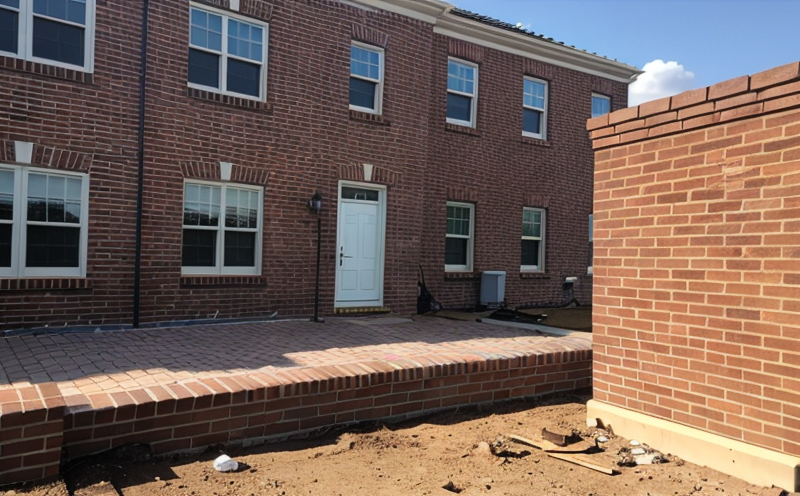ASTM C140 Unit Shape and Size Verification
The ASTM C140 standard provides a method to verify the shape and size of masonry units such as bricks, blocks, and other similar materials. This service is essential for ensuring that manufactured units meet specified dimensions and geometric requirements set by industry standards. The accuracy in these specifications is crucial not only for aesthetic purposes but also for structural integrity in building construction.
Manufacturers must ensure their products comply with the ASTM C140 standard to avoid potential discrepancies during construction, which could lead to suboptimal performance of the structure or even safety hazards. This test plays a vital role in maintaining quality control throughout the production process and ensuring that each unit is consistent with industry standards.
The verification process involves precise measurements using calibrated instruments to evaluate both external dimensions and internal dimensions such as cores, holes, or grooves within the units. The test helps identify any variations from standard sizes which can impact the overall performance of the structure. Understanding these nuances ensures that builders and architects have reliable materials when constructing buildings, roads, bridges, and other infrastructure projects.
For quality managers, compliance officers, R&D engineers, and procurement teams responsible for material selection, this service offers valuable insights into product consistency and adherence to specifications. By leveraging ASTM C140 unit shape and size verification, stakeholders can mitigate risks associated with non-compliant materials and enhance their reputation within the construction industry.
The importance of maintaining accurate dimensions cannot be overstated; even minor deviations from standard sizes can significantly affect a building's stability and durability. Therefore, it is imperative for all parties involved in masonry unit manufacturing to adhere strictly to ASTM C140 guidelines during production.
Scope and Methodology
| Aspect | Description |
|---|---|
| External Dimensions | Measurements of the overall length, width, height, and other relevant external dimensions are taken using calibrated measuring tools. |
| Internal Dimensions | If applicable, internal features such as cores or holes are measured to ensure they meet specified sizes and shapes. |
| Geometric Tolerances | Evaluates whether the actual dimensions fall within acceptable tolerances defined by ASTM C140 standards. |
| Visual Inspection | A visual assessment is conducted to check for any visible flaws or irregularities that may affect the unit's performance. |
The test typically involves sampling a representative number of units from a batch, ensuring that each sample accurately reflects the entire production lot. Following collection, the specimens undergo rigorous measurement and evaluation according to ASTM C140 criteria. Once completed, detailed reports are generated summarizing findings along with any necessary recommendations.
Why Choose This Test
- Ensures Compliance: By verifying that masonry units adhere strictly to ASTM C140 standards, manufacturers demonstrate their commitment to quality and regulatory compliance.
- Enhances Reputation: Consistent adherence to industry best practices helps establish a company's reputation for reliability and excellence in the construction sector.
- Promotes Safety: Ensuring that every unit meets specified dimensions reduces the risk of structural failures or accidents on-site.
- Facilitates Quality Control: Regular verification enables manufacturers to identify potential issues early, allowing for corrective actions before full-scale production begins.
- Fosters Trust: Independent third-party verification adds credibility and trustworthiness to the brand among clients and stakeholders.
- Saves Costs: Early identification of non-compliant units prevents costly rework or scrap during manufacturing processes.
The ASTM C140 unit shape and size verification is a critical component in maintaining high standards across the masonry industry. It provides peace of mind knowing that every product meets stringent quality requirements, thereby contributing to safer, more durable structures.
International Acceptance and Recognition
- ISO 9001: The ASTM C140 standard aligns closely with ISO 9001 principles, promoting continuous improvement in quality management systems.
- ASTM International: Recognized globally by the American Society for Testing and Materials (ASTM), this standard is widely accepted across North America and beyond.
- EN Standards: European Norms (EN) often incorporate ASTM C140 standards, making it a key reference point in Europe as well.
- IEC Standards: The International Electrotechnical Commission (IEC) has adopted some elements of ASTM C140 for certain applications involving electrical masonry components.
- Other National Standards Bodies: Many countries have national standards organizations that recognize and adopt ASTM C140, ensuring broad international acceptance.
The wide adoption of ASTM C140 by various regulatory bodies highlights its relevance and importance in the global construction industry. Its universality ensures that manufacturers can confidently export their products while meeting local regulations worldwide.





